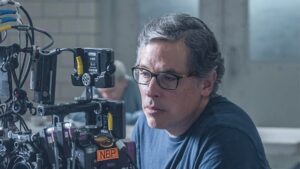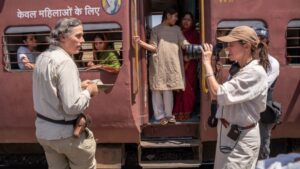
Director Julie Taymor‘s The Glorias splits the life of journalist Gloria Steinem into four characters, played by (from younger to older) Ryan Keira Armstrong, Lulu Wilson, Alicia Vikander and Julianne Moore. Based on Steinem’s book My Life on the Road, and co-written by Taymor and playwright Sarah Rule, The Glorias screened at the 2020 Sundance Film Festival before a virtual release on Amazon Prime Video in September.
This is the third collaboration between Taymor and cinematographer Rodrigo Prieto, ASC, AMC after Frida and A Midsummer Night’s Dream. Prieto gained worldwide attention twenty years ago when he shot Amores Perros for director Alejandro Iñárritu. Since then he has worked with directors like Ang Lee (Brokeback Mountain), Curtis Hanson (8 Mile), and Martin Scorsese (Silence, The Irishman, both Oscar-nominated for cinematography). Prieto has also shot commercials and music videos, including three this year with Taylor Swift. His next project is Scorsese’s Killers of the Flower Moon.
Prieto spoke with Below the Line via Zoom during this year’s EnergaCAMERIMAGE.
Below the Line: Have you had any issues with Covid-19?
Rodrigo Prieto: No, thankfully. I’ve been working, filming commercials since July. It feels pretty controlled, a lot of emphasis on masks and social distance. Also a shield when you approach an actor. But you never know.
BTL: How early in the project did you join The Glorias?
Prieto: Julie and I have been friends since Frida. She told me about the project, spoke very passionately about it. I hadn’t read the script at that point, but I immediately said of course I’ll do this.
For budgetary reasons, we ended up filming in Savannah, Georgia. That was actually the most challenging part for me. The story has absolutely nothing to do with Savannah. We had to recreate New York, Houston, all these other locations in a city that has very distinctive architecture, Spanish moss on the trees, things like that.

BTL: How did you and Taymor approach the story’s different time periods?
Prieto: What I decided to try was to emulate different movie film stocks. I did something similar on The Irishman, but there, I was emulating still photography emulsions. These days we don’t have all the different film stocks we had fifteen years ago. Then there were maybe six Fuji stocks. Kodak had four or five. So you could actually choose different color saturations, different grain structures, different contrast styles. That’s been lost.
We were originally going to shoot on film, but we ended up using the Sony VENICE. So I decided to bring back those Fuji and Kodak stocks by creating LUTs [look-up tables] that emulated them. I shot tests of day exteriors, night shots, studio interiors with costumes. When I screened them for Julie, we agreed that for Gloria’s early childhood, we would use Kodak 5229, a low-contrast stock with low color saturation. And for scenes in the 1970s, we went with Fuji Vivid for its higher color saturation.
BTL: You have to be careful switching back and forth because you want to avoid jarring viewers.
Prieto: It’s a subtle distinction, but it did give a feel for different eras. If you have a mishmash of all sorts of textures, it would take you out of the story, and there are other parts of The Glorias that are not subtle, like the “Bus Out of Time,” which is in black-and-white.
BTL: At one point all four Glorias are in a single shot on that Bus Out of Time. When did Taymor decide to use that device as a transition between the time periods?
Prieto: Julie had decided to do that before I joined. Pretty early on she was talking about making those scenes black-and-white, so then the big question became: what do we do outside the windows? Because there are many eras and locations. We look out the bus windows to India, for example. India’s so colorful, so would that be in black-and-white?
We tested a lot, at first with just photos, seeing how it looked with still images. But we couldn’t get a good sense until we actually started tests with movement. We had to decide what was going to be outside the windows when the exteriors didn’t matter, when a scene wasn’t connected to a specific place.
Also, do you shoot the bus actually moving? Or in a studio? Just for scheduling it was much more practical to shoot the bus in a studio, surrounded by green screen.
BTL: How much was involved in a shot that moves from the bus interior to an exterior in India?
Prieto: To me, everything is about common sense and perspective and contrast. Visual effects is about tricks, and there are certain ways to sell a trick. By the way, cinematography is also trickery, you’re creating moods and depth that might not exist in situations. You’re making it look sunny when it’s not, night when it’s day. All these tricks we’re constantly using, I love that part of my job.
Visual effects is an extension of that. Once we knew that we wanted to have exteriors in color when we were connecting scenes, the challenge was how do we match the scene outside to the scene inside. How do we make it relatively realistic, even though it’s obviously not.
Where we see young Gloria in the bus and a scene in India happening outside in the same shot — first we shot the bus in the warehouse in Savannah with a green screen. I knew the camera’s height from the ground, the focal length of the lens, and the angle of the camera. So when we went to India, we put the camera on a Steadicam on the back of a truck, matched the exact height of the camera, the focal length, and the angle. So it really does match very well, because those elements were exactly the same.
But there were moments where we were not looking for an exact match. The most obvious one may be the young Gloria inside the bus, and outside we see Toledo. That’s stock footage, and the perspective is all wrong, shots going in a different direction to the inside.
When I first saw them together, I thought “It’s a disaster, it’s all wrong.” But then I figured that it’s actually good, because this is a case where it’s her memory, and the imagery becomes more abstract.

BTL: One startling scene when Steinem is interviewed on TV evokes the tornado sequence in The Wizard of Oz.
Prieto: From the beginning Julie had this notion that the moment would include the little girl flying on a broom. It was a long process figuring out how to get there, what to do and how to achieve it physically.
We had the location, a television studio. We knew that the atmosphere would change, it was written into the script: “Suddenly everything becomes red.” So I knew I had to go from television studio lighting to a red wash. Figuring out how the set revolves, the whole thing with dry ice, all these ideas came out as we were progressing.
It was challenging to understand when it would become a full-on tornado, and what part of it was going to have elements of the studio set. It was a little-by-little process to determine what we would shoot against a green screen.
For the girl on a broom, we had the broom literally on a wire going around in circles. We also hung the chair with the interviewer, and [we] swiveled that. After a couple of takes that actor was pretty dizzy, and I had the camera on a Technocrane moving around actresses on a turntable against a green screen, with moving lights and lightning.
Everything else — the tornado itself, the papers flying around, the wimple of a nun — all that was created by visual effects.
BTL: It seems like The Glorias was one huge problem after another.
Prieto: This was one of the most challenging movies I’ve done. In many respects. From a technical standpoint but also logistical and budgetary.
The script didn’t have long dialogue passages, so there were not only complicated scenes but a lot of scenes. We were constantly moving. One day you have a scene in Central Park, and then the next scene in Washington. It was challenging for the actors, too. “Okay, now it’s twenty years later” on the same day.

BTL: You were supposed to begin your next film, Killers of the Flower Moon, last March.
Prieto: I can’t say much about it. We’re still pushing forward. We were prepping a year ago. Actually in November 2019, I was already in prep. We found some locations in Oklahoma… then it sort of paused, and then Covid. I’m really hoping we can get to it, start prepping again. I don’t have much more to say except I’m excited. We will have to start over.
BTL: When will you feel comfortable returning to a movie theater? I hate watching movies on a computer.
Prieto: I hope these vaccines start working. The longer it takes to go back to cinemas, the more difficult it will be for people to go out to see a movie rather than staying home.
But having said that, I do believe we need to connect with other people. That’s why we go to concerts as opposed to just listening to music on headphones. That’s why we go to the theater, that’s why we go out with a bunch of people to experience something together. It’s not just the size of the screen or the sound and the quality, it’s the fact that you’re sharing a common experience. Cinema gives us something spiritual, and I think people will gravitate back to it when we’re able.
The Glorias is now available on Prime Video. You can also read Daniel’s interview with the film’s Composer Elliot Goldenthal.
All photos courtesy of LD Entertainment and Roadside Attractions, except where noted.





